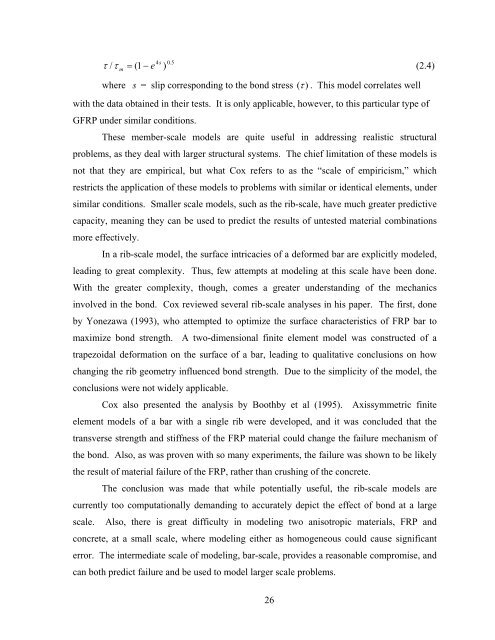Steel Free Hybrid Reinforcement System for Concrete Bridge Decks ...
Steel Free Hybrid Reinforcement System for Concrete Bridge Decks ...
Steel Free Hybrid Reinforcement System for Concrete Bridge Decks ...
You also want an ePaper? Increase the reach of your titles
YUMPU automatically turns print PDFs into web optimized ePapers that Google loves.
4 s<br />
τ / τ (1 ) 0.5<br />
m<br />
= − e<br />
(2.4)<br />
where s = slip corresponding to the bond stress (τ ) . This model correlates well<br />
with the data obtained in their tests. It is only applicable, however, to this particular type of<br />
GFRP under similar conditions.<br />
These member-scale models are quite useful in addressing realistic structural<br />
problems, as they deal with larger structural systems. The chief limitation of these models is<br />
not that they are empirical, but what Cox refers to as the “scale of empiricism,” which<br />
restricts the application of these models to problems with similar or identical elements, under<br />
similar conditions. Smaller scale models, such as the rib-scale, have much greater predictive<br />
capacity, meaning they can be used to predict the results of untested material combinations<br />
more effectively.<br />
In a rib-scale model, the surface intricacies of a de<strong>for</strong>med bar are explicitly modeled,<br />
leading to great complexity. Thus, few attempts at modeling at this scale have been done.<br />
With the greater complexity, though, comes a greater understanding of the mechanics<br />
involved in the bond. Cox reviewed several rib-scale analyses in his paper. The first, done<br />
by Yonezawa (1993), who attempted to optimize the surface characteristics of FRP bar to<br />
maximize bond strength. A two-dimensional finite element model was constructed of a<br />
trapezoidal de<strong>for</strong>mation on the surface of a bar, leading to qualitative conclusions on how<br />
changing the rib geometry influenced bond strength. Due to the simplicity of the model, the<br />
conclusions were not widely applicable.<br />
Cox also presented the analysis by Boothby et al (1995). Axissymmetric finite<br />
element models of a bar with a single rib were developed, and it was concluded that the<br />
transverse strength and stiffness of the FRP material could change the failure mechanism of<br />
the bond. Also, as was proven with so many experiments, the failure was shown to be likely<br />
the result of material failure of the FRP, rather than crushing of the concrete.<br />
The conclusion was made that while potentially useful, the rib-scale models are<br />
currently too computationally demanding to accurately depict the effect of bond at a large<br />
scale. Also, there is great difficulty in modeling two anisotropic materials, FRP and<br />
concrete, at a small scale, where modeling either as homogeneous could cause significant<br />
error. The intermediate scale of modeling, bar-scale, provides a reasonable compromise, and<br />
can both predict failure and be used to model larger scale problems.<br />
26

















